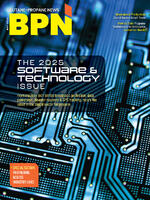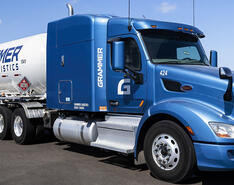
Since 2019, Cargas Energy’s “Top Technology Trends in Fuel Delivery” (Tech Trends) report has gathered data about how energy companies use technology. Based on data collected over the past six years, it’s clear that technology’s capabilities and usage have only expanded in the fuel delivery industry. Companies of all sizes are actively investing in additional technology, prioritizing new business software and keeping a close eye on cutting-edge features that could play a key role in future deliveries.
Software Diversification
Fuel dealers are bringing accounting, tank monitoring and payment processing in-house to keep data accessible and simplify decision-making processes. The 2025 Tech Trends survey found that 93% of respondents use two or more solutions — in addition to fuel delivery software — to manage their business. More than half of respondents reported using payroll and HR systems, credit card gateways and processors, accounting solutions, and customer web portals. These top solutions prove that energy companies are investing in both internal operational systems and external relationship management systems.
On the customer relationship side, the Tech Trends survey noted that fuel dealers primarily use two or more systems to communicate with customers. Phone and email communications are still the most widely used and personable options, but social media usage and chat tools play important roles in pushing out company messages and building brand familiarity and expertise. These relationships are further bolstered by self-service options like online bill pay, autopay and account management, which have only grown in popularity since the start of the COVID-19 pandemic in 2020.
While ensuring a positive customer experience is crucial, the most desirable self-service tools and internal software prioritize revenue. Fuel dealers reckon daily with rising costs and shrinking supply, which creates demand for accurate and immediate financial data. Tools for payroll and bookkeeping satisfy this demand and provide businesses with a snapshot of cash flow. When external variables create concerns, fuel dealers can use this data to quickly pivot, adjust their strategy and make the best possible decisions for their business.
Prioritizing New Solutions
Strong tech stacks for fuel dealers require breadth and depth; this means energy companies have a vested interest in upgrading outdated systems to keep pace with the diverse tech they’re acquiring.
The most prominent system for energy companies is fuel delivery software. This solution serves as a centerpiece for operations, often connecting to and synchronizing with hardware such as flow meters, driver tablets and tank monitors, plus other software like accounting systems and customer relationship management (CRM). Fuel delivery software purchases doubled between the 2024 and 2025 Tech Trends surveys, with 12% of respondents to the most recent survey reporting a fuel delivery software investment for the year. To add to this, fewer fuel dealers are willing to wait seven or more years to make a fuel delivery software purchase.
Given that more than half of respondents purchased their current fuel delivery systems within the past seven years, it’s clear that the days of green screen software are long gone for a majority of energy companies.
Fuel dealers are integrating these modern fuel delivery solutions with software for accounting, sales and marketing, and customer experience to build data-rich reports that measure key metrics like total sales, profit and gallons delivered. However, to synchronize this data to the fuel delivery system, fuel dealers need other solutions with powerful integration capabilities; the best way to ensure seamless data transfer is to invest in contemporary software across the entire organization.
Cutting-Edge Features
What does the future of fuel delivery look like? While the next few years aren’t set in stone, fuel dealers have theories about the role emerging technology will play.
Cloud computing is one of the three main areas fuel dealers are tracking. One-third of respondents to the 2025 Tech Trends survey said they struggle to gain business insights from current data and systems. Whether this is due to clunky interfaces, poor data synchronization or a combination of both, it’s bothersome enough that fuel delivery companies seek the power to pull data from across the business and generate reports. Specifically, they want to reduce the manual labor associated with critical business tasks, including data entry and report generation, by implementing workflow automation.
Workflow automation is one of the top ways a fuel delivery outfit can cut wasted time and aim for increased revenue. For instance, if a customer asks a visiting tech for a repair or installation quote, the tech can enter this information digitally and generate the quote immediately. That information is then stored in the fuel delivery software and can be referenced by the sales and customer experience teams during future interactions. Data automation ensures that no valuable information is left behind, and the decrease in required manual entry simultaneously reduces data errors — no more misplacing paper tickets, hastily scribbled quotes or other important information.
Cloud computing and workflow automation already exist in modern fuel delivery software to some capacity. But artificial intelligence (AI) — the biggest business buzzword since 2023 — has fuel dealers feeling equal parts curious and cautious. AI covers an array of solutions and capabilities, and fuel dealers wonder what role it will play in generating and adjusting routes, improving K-factors and communicating with customers. AI may not drive a bobtail or refill a tank, but energy companies are certain it’s coming to their industry.
The Future of Fuel
The biggest issues impacting the fuel delivery industry are bigger than any tech stack can manage. From low hiring and retention to government regulations and inflation in the face of fluctuating inventory, fuel dealers have plenty of concerns. However, it seems fuel delivery companies have decided to focus on the things they can control — primarily, saving time and money while keeping customers happy.
The key to stability during a time of turmoil is efficiency. And whether that means investing in better software, expanding business toolkits or experimenting with the latest technology, fuel delivery companies are more willing than ever to pay top dollar for a higher bottom line.
The full report is available at cargasenergy.com/tech-trends-2025.


